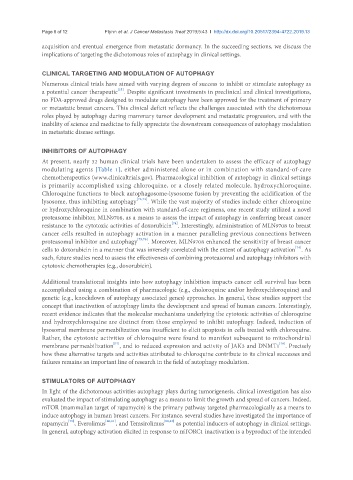Page 329 - Read Online
P. 329
Page 6 of 12 Flynn et al. J Cancer Metastasis Treat 2019;5:43 I http://dx.doi.org/10.20517/2394-4722.2019.13
acquisition and eventual emergence from metastatic dormancy. In the succeeding sections, we discuss the
implications of targeting the dichotomous roles of autophagy in clinical settings.
CLINICAL TARGETING AND MODULATION OF AUTOPHAGY
Numerous clinical trials have aimed with varying degrees of success to inhibit or stimulate autophagy as
[35]
a potential cancer therapeutic . Despite significant investments in preclinical and clinical investigations,
no FDA-approved drugs designed to modulate autophagy have been approved for the treatment of primary
or metastatic breast cancers. This clinical deficit reflects the challenges associated with the dichotomous
roles played by autophagy during mammary tumor development and metastatic progression, and with the
inability of science and medicine to fully appreciate the downstream consequences of autophagy modulation
in metastatic disease settings.
INHIBITORS OF AUTOPHAGY
At present, nearly 32 human clinical trials have been undertaken to assess the efficacy of autophagy
modulating agents [Table 1], either administered alone or in combination with standard-of-care
chemotherapeutics (www.clinicaltrials.gov). Pharmacological inhibition of autophagy in clinical settings
is primarily accomplished using chloroquine, or a closely related molecule, hydroxychloroquine.
Chloroquine functions to block autophagosome-lysosome fusion by preventing the acidification of the
lysosome, thus inhibiting autophagy [72,73] . While the vast majority of studies include either chloroquine
or hydroxychloroquine in combination with standard-of-care regimens, one recent study utilized a novel
proteasome inhibitor, MLN9708, as a means to assess the impact of autophagy in conferring breast cancer
[74]
resistance to the cytotoxic activities of doxorubicin . Interestingly, administration of MLN9708 to breast
cancer cells resulted in autophagy activation in a manner paralleling previous connections between
proteasomal inhibitor and autophagy [75,76] . Moreover, MLN9708 enhanced the sensitivity of breast cancer
cells to doxorubicin in a manner that was inversely correlated with the extent of autophagy activation . As
[74]
such, future studies need to assess the effectiveness of combining proteasomal and autophagy inhibitors with
cytotoxic chemotherapies (e.g., doxorubicin).
Additional translational insights into how autophagy inhibition impacts cancer cell survival has been
accomplished using a combination of pharmacologic (e.g., choloroquine and/or hydroxychloroquine) and
genetic (e.g., knockdown of autophagy associated genes) approaches. In general, these studies support the
concept that inactivation of autophagy limits the development and spread of human cancers. Interestingly,
recent evidence indicates that the molecular mechanisms underlying the cytotoxic activities of chloroquine
and hydroxychloroquine are distinct from those employed to inhibit autophagy. Indeed, induction of
lysosomal membrane permeabilization was insufficient to elicit apoptosis in cells treated with chloroquine.
Rather, the cytotoxic activities of chloroquine were found to manifest subsequent to mitochondrial
[77]
[78]
membrane permeabilization , and to reduced expression and activity of JAK3 and DNMT1 . Precisely
how these alternative targets and activities attributed to chloroquine contribute to its clinical successes and
failures remains an important line of research in the field of autophagy modulation.
STIMULATORS OF AUTOPHAGY
In light of the dichotomous activities autophagy plays during tumorigenesis, clinical investigation has also
evaluated the impact of stimulating autophagy as a means to limit the growth and spread of cancers. Indeed,
mTOR (mammalian target of rapamycin) is the primary pathway targeted pharmacologically as a means to
induce autophagy in human breast cancers. For instance, several studies have investigated the importance of
[79]
rapamycin , Everolimus [80,81] , and Temsirolimus [80,82] as potential inducers of autophagy in clinical settings.
In general, autophagy activation elicited in response to mTORC1 inactivation is a byproduct of the intended

